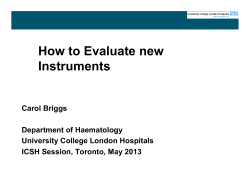
Document 2157
Improved Post-Thaw Stability Validation of Peripheral Blood Cell Products utilizing the Intracellular-like CryoStor® Cryopreservation Solution, and Preliminary Results of Clinical Application Gerhard Fritsch, PhD1, Volker Witt, MD1, Susanne Matthes, MD1, Michael Dworzak, MD1, Michaela Artwohl, PhD1, Dominic Clarke, PhD2 and Aby J. Mathew, PhD2 Cancer Research Institute (CCRI), St. Anna Kinderkrebsforschung, Vienna, Austria and 2BioLife Solutions, Inc., Bothell, WA, United States In this evaluation of cryopreservation methods for clinical application, cell samples from apheresis products were cryopreserved in a conventional isotonic-based freeze media (CFM; 20% DMSO, 10% human plasma derivate in Ringer’s solution) or intracellular-like CryoStor® CS10 (CS10; contains 10% DMSO, serum-free and protein-free) reported to have favorable properties (Stylianou et al., Cytotherapy 2006, and Clarke et al., Cytotherapy 2009). 7 8 9 0 10 DMSO Experiment Experiment Triplicate analyses of CS10 [ ] & CFM [ 0 Cryostor ] DMSO Cryostor Figure 1 Cell recovery immediately after thawing (t=0; n=10) DMSO = CFM CryoStor = CS10 * ** *** = p<0.05 = p<0.01 = p<0.001 CD34&WBC:n=8, TCells:n=5 Cell Recovery after Thawing [%] CD34&WBC:n=8, TCells:n=5 T0&T30:n=6, T60:n=3 Figure 2 Cell recovery after 20 min (WBC & CD34: n=8; T-cells: n=5) Cell Recovery after Thawing [%] 0 el ls 6 C 5 T 4 20 W BC 3 0 T 60 T 30 40 34 2 20 T0 60 D 1 T 60 40 80 C 0 T 30 60 el ls 10 T0 80 C 9 100 W BC 8 0 100 ** * ** 120 T 7 20 * 140 120 34 6 40 *p<0.05 **p<0.01 vs. CM CS 10 140 D 5 0 T 20 CS10 Conventional Medium C 4 20 T0 60 el ls 3 40 ** * 80 C 2 T0 T 20 60 * T 1 40 20 10 0 0 60 * 100 34 20 20 10 30 80 80 120 D 20 40 100 W BC 40 50 120 Cell Recovery after Thawing [%] 60 100 C 30 80 60 CFM *p<0.05 **p<0.01 vs. CM CS 10 el ls 40 70 100 * 120 C 50 120 CS10 Conventional Medium 140 *** T 60 80 CFM D3 4 Recovery CD34 [%] 70 90 140 CD34+ W BC 80 WBC Recovery WBC [%] 90 0 The Children’s Cancer Research Institute (CCRI) conventional isotonic-based freezing medium (CFM) used for the last 15 years comprised 20% DMSO & 10% human plasma derivate in Ringer’s solution. Some issues observed in clinical practice were: 1) Infusion of high volumes was necessary in case of poor mobilizers (DMSO limit: 1g/kg BW) 2) To prevent cell clotting, cells had to be infused cold & rapidly, & immediately after thawing 3) Experienced 2 cases of cell clotting before the end of infusion. CD34+ 160 Cell Recovery after Thawing [%] WBC 100 Recovery WBC [%] Collection and cryopreservation of autologous stem cells is a routine procedure in a variety of malignant diseases. Further, improved stability of cell products is critical to the development of cell and tissue based therapies as part of the growth in regenerative medicine. A growing body of evidence indicates that one key method for improved cryopreservation efficacy is the utilization of a hyperosmotic/intracellular-like cryopreservation media, as opposed to the traditional use of an isotonic/extracellular-like media such as saline as the vehicle for the cryoprotectant. Post-Thaw Validation and Stability Results Figures C Introduction Recovery CD34 [%] 1Children's T0&T30:n=6, T60:n=3 Figure 3 Cell recovery after 30 & 60 min (t=30: n=5; t=60 n=3) Post-Thaw Validation and Stability Results Discussion Immediately after thawing, the percent recovery of WBC was 50.7 (±14.4%) for CFM versus 70 (±11.6%) for CS10 (p<0.001), and that of CD34+ cells was 81.8 (±36.1%) for CFM and 101 (±16.4%) for CS10 (p<0.05). In CFM, 20 to 60 minutes after thawing there was a dramatic loss in cell viability (-40% to -90%), up to complete clotting in 3/10 samples. By contrast, cells remained viable up to 60 minutes after thawing in CryoStor CS10, and no clotting occurred. Because of these positive validation results, cryopreservation in the intracellular-like CryoStor CS10 was translated to clinical application for treatment of hematological malignancies. Methods Ten cell samples from 6 different apheresis products were mixed (1+1) with either CFM or with CS10, frozen by controlled rate freezing, and stored in the vapor phase over liquid N2. After thawing, viable CD34+, WBC and T-cells were quantified by triplicate single-platform 5-color Flow Cytometric analysis. Analyses were performed immediately after thawing, and after 20, 30, and 60 minutes post-thaw. Regeneration of patients after infusion of autologous PBSC (n=8) To date, eight patients have received autologous stem cells cryopreserved in CryoStor CS10. (CD34+ x 10E6/kg = 1.8 to 14; mean 4.9), in a mean volume of 126 ml (65 to 212 ml) containing 0.4g DMSO/kg (0.1 to 0.6). Infusions were well tolerated, no side effects were observed. Both WBC>1000 and ANC>500 were reached on day +10.5 (WBC:8-12; ANC:7-12). Conclusions CryoStor CS10 has demonstrated benefits in comparison to the previous standard CFM in terms of cell recovery post-thaw, particularly providing improved stability after 20 to 60 minutes post-thaw at room temperature (RT) in these validation experiments: 1) significantly (> 20%) more viable CD34+ 2) 50% less final DMSO concentration 3) advantage for poor mobilizers: higher infusion volumes possible Preliminary results in patients (n=8 reinfusions) are promising. Physicians report good regeneration kinetics, even after infusion of low CD34+ numbers, and no engraftment failure occurred. Further data will be collected to validate the outcome of hematopoietic regeneration after reinfusion.
© Copyright 2025









![TMRE [Tetramethylrhodamine ethyl ester]](http://cdn1.abcdocz.com/store/data/000008077_2-57b5875173b834fce2711afeb6b289d6-250x500.png)











